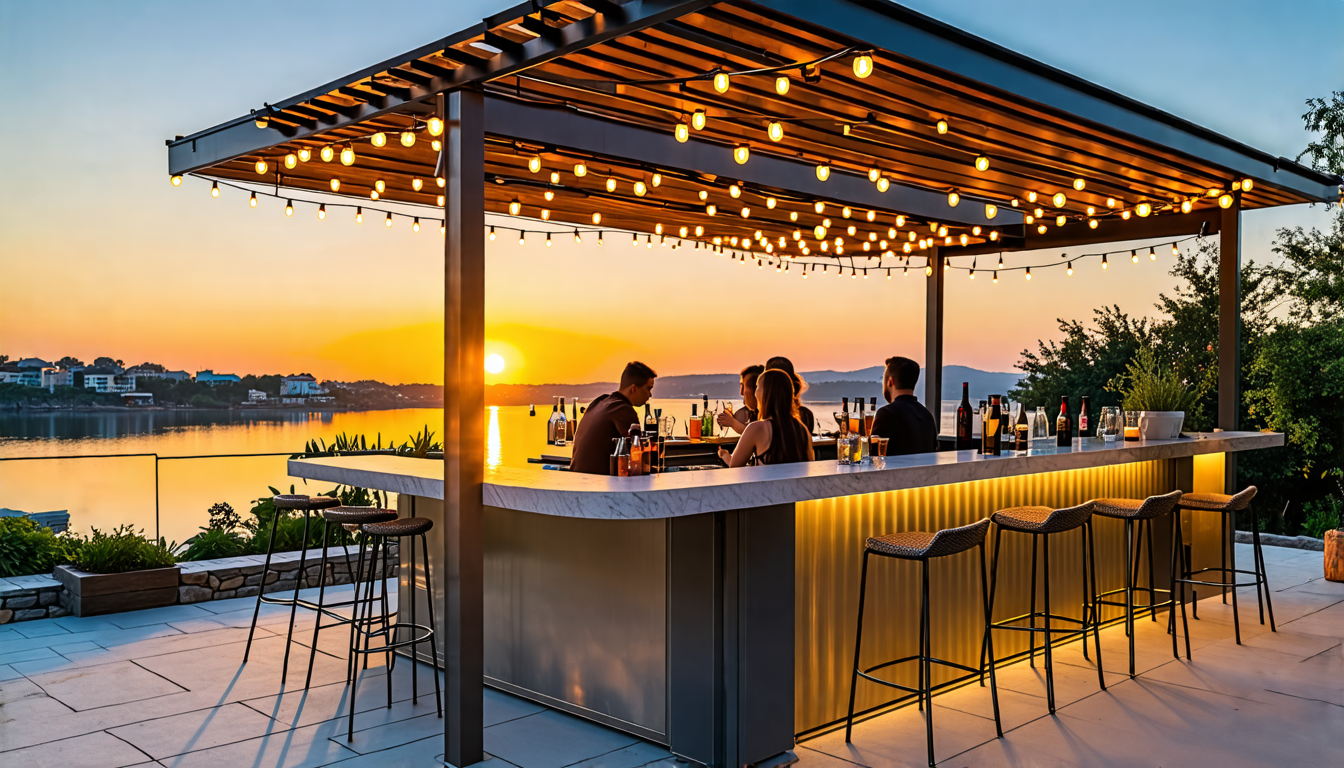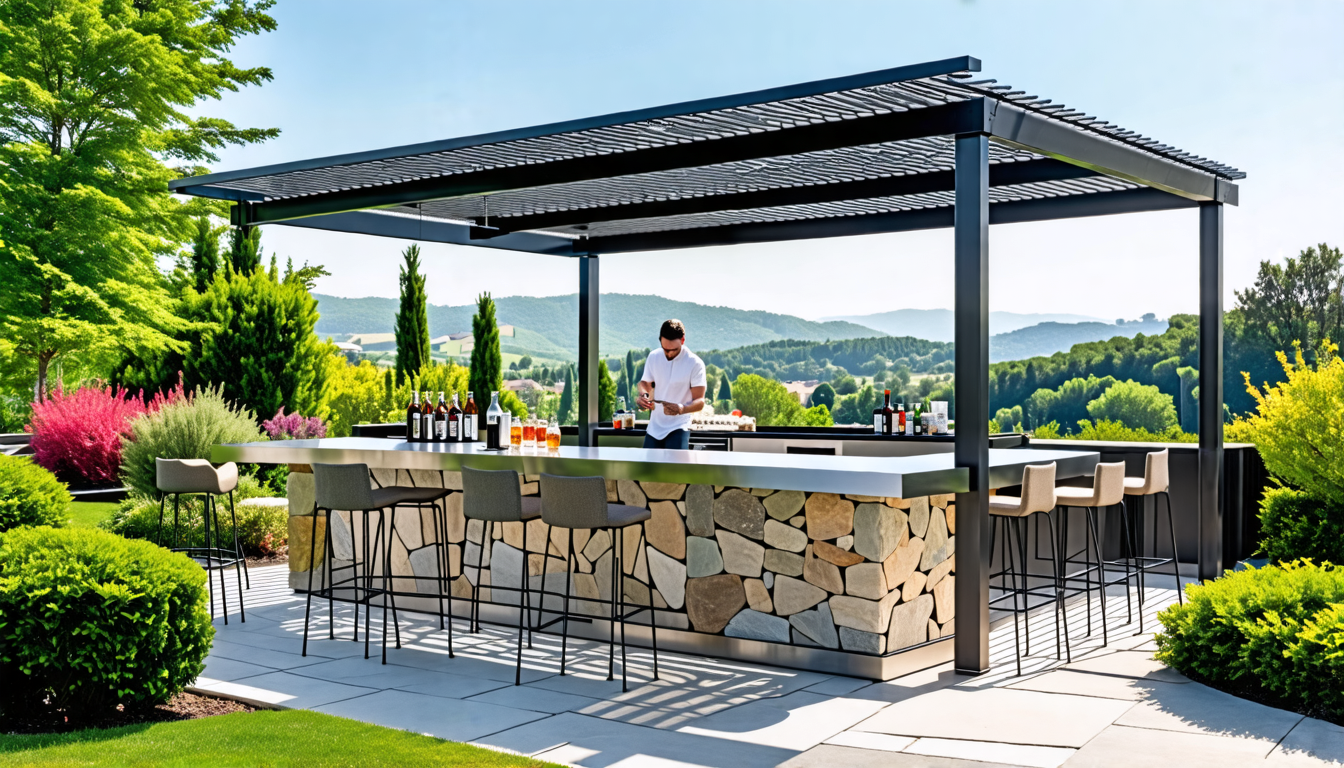When designing and maintaining an outdoor bar, one of the primary concerns is preventing corrosion, which can significantly degrade the appearance and functionality of your setup. Corrosion is the gradual destruction of materials, predominantly metals, through chemical reactions with environmental elements such as moisture and oxygen. In the context of outdoor bars, materials like steel and untreated wood are particularly vulnerable, especially in areas with high humidity, salt air, or frequent rainfall. Understanding the impact of corrosion on outdoor bars is crucial to ensuring their longevity and durability.
Environmental factors play a significant role in accelerating corrosion. For instance, metals exposed to salty air, common in coastal regions, are more prone to rusting. Likewise, constant exposure to rain and humidity can result in wood rot and metal oxidation. Therefore, choosing the right materials and employing effective prevention strategies are key to extending the lifespan of outdoor bars.
To combat corrosion, it’s essential to use corrosion-resistant materials such as stainless steel, which naturally withstands rust and degradation. Treated wood can also offer a higher level of protection against the elements. Applying protective coatings and sealants can further shield your bar components from moisture and corrosive substances. Regular maintenance, such as cleaning surfaces and inspecting for early signs of wear, is also crucial. Additionally, thoughtful design considerations, like ensuring proper drainage and minimizing trapped water, can help reduce corrosion risks.
Incorporating these strategies not only preserves the structural integrity and aesthetic appeal of your outdoor bar but also saves time and money on repairs and replacements in the long run.
Understanding the Impact of Corrosion on Outdoor Bars
Definition and Explanation of Corrosion
Corrosion is a natural process that occurs when materials, particularly metals, deteriorate due to chemical reactions with environmental elements. The most common type of corrosion is rust, which happens when iron reacts with oxygen and moisture in the air. However, corrosion can affect a wide range of materials and take various forms, impacting everything from the aesthetics to the structural integrity of your outdoor bar.
Common Materials Susceptible to Corrosion in Outdoor Bar Settings
In outdoor bar settings, several materials are particularly prone to corrosion. Understanding these materials can help you make informed decisions when designing and maintaining your bar. The most susceptible materials include:
- Iron and Steel: These are commonly used in the construction of bar frames and furniture. They are highly susceptible to rust, especially in humid or salty environments.
- Aluminum: While more resistant to rust than iron and steel, aluminum can still corrode, particularly in the presence of saltwater or acidic environments.
- Copper: Often used in bar fixtures and accents, copper can develop a patina over time. Though this green coating protects the underlying metal, it can be undesirable aesthetically.
- Wood: Natural wood can deteriorate due to moisture, fungi, and insects, leading to rot and structural weakness.
How Environmental Factors Contribute to Corrosion
Environmental factors play a significant role in the rate and severity of corrosion. Here are some of the key factors that impact outdoor bars:
Humidity: High humidity levels increase the amount of moisture in the air, promoting the oxidation process that leads to rust and other forms of corrosion. Outdoor bars in tropical or coastal regions are particularly at risk.
Salt Air: Locations close to the ocean experience higher levels of salt in the air. Salt accelerates the corrosion process, especially for metals like iron and steel. Even materials like aluminum and stainless steel, which are generally more corrosion-resistant, can suffer in salty conditions.
Rain: Regular exposure to rain can lead to water accumulation on surfaces, exacerbating the corrosion process. The intermittent wet-dry cycles caused by rain increase the likelihood of rust formation on metal surfaces.
Temperature Fluctuations: Significant variations in temperature can cause materials to expand and contract, leading to cracks and weaknesses where moisture and air can penetrate, accelerating the corrosion process.
Pollutants: Urban environments with high levels of industrial pollution can expose outdoor bars to acidic compounds that accelerate corrosion. Sulfur dioxide, for example, can react with moisture to form sulfuric acid, which is highly corrosive.
Understanding these environmental factors and their impact on corrosion can help you take proactive measures to protect your outdoor bar. By selecting corrosion-resistant materials and implementing appropriate maintenance practices, you can significantly extend the lifespan and aesthetic appeal of your outdoor bar setup.

Effective Strategies for Preventing Corrosion in Outdoor Bars
Use of Corrosion-Resistant Materials
Choosing the right materials is paramount for preventing corrosion in outdoor bars. Opt for corrosion-resistant materials such as stainless steel and treated wood. Stainless steel, particularly grades like 304 and 316, offers exceptional resistance against corrosion due to its chromium content. Treated wood, often pressure-treated with chemicals to resist moisture and insects, can also withstand the rigors of outdoor environments. These materials not only enhance the durability of your outdoor bar but also reduce the long-term costs associated with repairs and replacements.
Application of Protective Coatings and Sealants
Another effective strategy involves the application of protective coatings and sealants on your outdoor bar components. Coatings like powder coatings, galvanization, and epoxy paints provide a physical barrier that shields metal surfaces from corrosive elements. For wooden surfaces, sealants and varnishes can prevent moisture penetration and minimize the effects of UV radiation. Regularly reapplying these protective layers ensures ongoing protection and maintains the aesthetic appeal of your outdoor bar.
Regular Maintenance Practices to Prolong Lifespan
Maintenance is crucial to keeping corrosion at bay. Implement a regular cleaning schedule to remove dirt, salt, and other corrosive substances. Use mild soap and water for periodic cleaning and avoid harsh chemicals that might damage protective coatings. Inspect joints, screws, and hidden areas for signs of corrosion, and address any issues promptly. Regular maintenance not only extends the lifespan of your outdoor bar but also keeps it looking pristine.
Design Considerations to Minimize Corrosion Risk
Thoughtful design can play a significant role in minimizing corrosion risks. Ensure your outdoor bar design facilitates proper drainage to avoid water accumulation, which can accelerate corrosion. Avoid flat surfaces where water can pool and ensure proper ventilation to reduce humidity levels. Additionally, using non-corrosive fasteners and fittings can prevent galvanic corrosion, which occurs when dissimilar metals come into contact. By incorporating these design considerations, you can significantly reduce the risk of corrosion and enhance your outdoor bar’s longevity.
In conclusion, by using corrosion-resistant materials, applying protective coatings, adopting regular maintenance practices, and considering smart design choices, you can effectively prevent corrosion and ensure your outdoor bar remains a durable and attractive feature of your home.
In conclusion, protecting your outdoor bar from corrosion is crucial to ensure its longevity and maintain its aesthetic appeal. Understanding the impact corrosion can have on various materials, especially in environments with high humidity, salt air, and frequent rain, allows you to make informed decisions about material selection and design. Utilizing corrosion-resistant materials such as stainless steel and treated wood, applying protective coatings and sealants, and adhering to regular maintenance practices are effective strategies to combat corrosion. Additionally, incorporating thoughtful design considerations can further minimize corrosion risks. By implementing these measures, you can enjoy a durable and visually pleasing outdoor bar for years to come.

